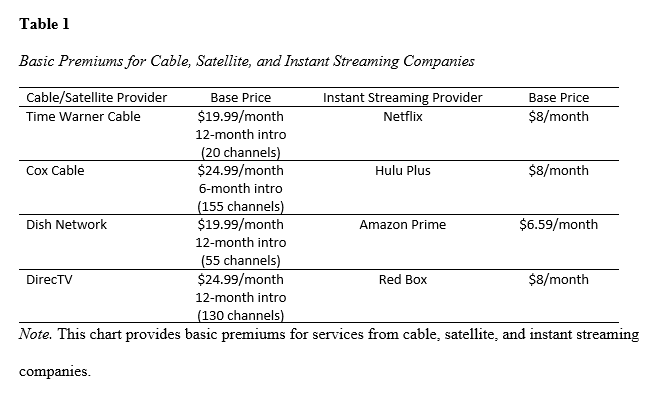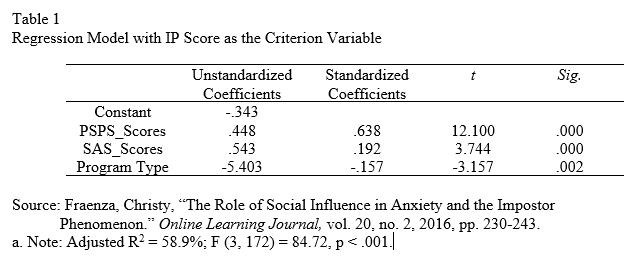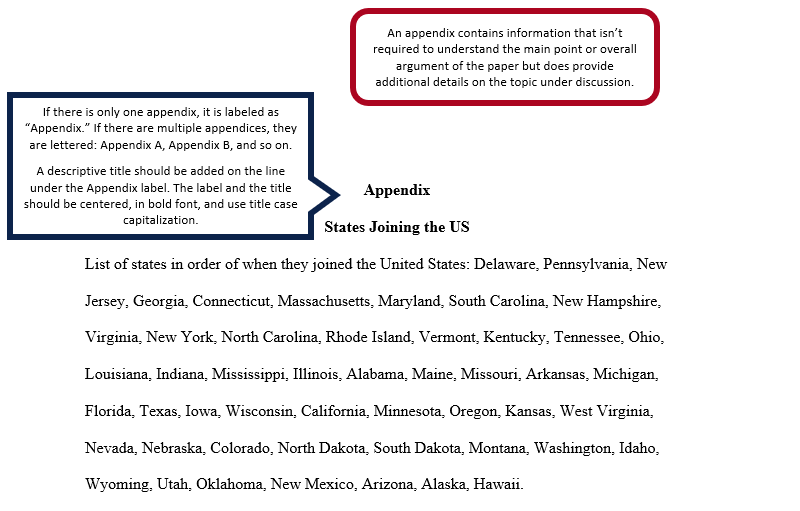For some papers and reports, you may choose to add a table, graph, chart, or image within the body of the draft. Or you may choose to include an appendix at the end of your paper. These can help to provide a visual representation of data or other information that you wish to relay to your reader. Follow the guidance below to understand when and how to use these features.
When do I use a table?
Use a table, chart, or graph when you are dealing with complex numerical data that requires precise values.
How do I incorporate a table into my paper?
Tables and graphs can be created on your own in Microsoft Word, or you can copy a table or graph from a source. An image or drawing can be copied and pasted from a source. Either way, you will need to format and cite your table, graph, or image in APA style.
How do I format a table in APA style?
Follow these directions to format and cite your table in APA style:
- Label and number the table using a bold font.
- Example: Table 1
- Give it a descriptive title in italics on the line after the table number and use italics for this title.
- Example: Regression Model with IP Score as the Criterion Variable
- Include all necessary information in the table so the reader can easily understand the data.
- Use a sans serif font that is large enough to read (such as Calibri, 11-pt)for any text within a table you create.
- Align the table flush-left on the page.
- Include a “Note.” on the line under the table. Your note should include:
- any additional information needed to understand the table
- a full reference citation if it was obtained from a source
- You should always refer to the table by its label within the text of your paper—don’t simply insert a table alone.
- Example: “The statistics on the percentage of animals for science that suffer can be seen in Table 3.”
Example of a Properly Formatted Table in APA:

How do I format a table in MLA style?
Follow these directions to format and cite your table in MLA style:
- Refer to the table in your text by using parentheses.
- Example: “This information (see Table 1) can be seen…”
- Label and number the table.
- Example: Table 1
- Give it a descriptive title on the line after the table label. Use standard title capitalization practices (capitalize main words).
- Example: Regression Model with IP Score as the Criterion Variable
- Align the table flush-left on the page.
- Include all necessary information in the table so the reader can easily understand the data.
- Under the table, cite the source information by writing “Source” followed by a colon. Then provide the correct MLA entry as you would on a Works Cited page, using commas instead of periods until the final punctuation. Use hanging indent if the entry goes beyond one line. If you enter this information correctly in this space, you are not required to enter it on your Works Cited page.
- Example:
Source: Fraenza, Christy, “The Role of Social Influence in Anxiety and the Impostor Phenomenon,” Online Learning Journal, vol. 20, no. 2, 2016, pp. 230-243.
- Example:
- To include additional information required to understand the table, use an alphabetic footnote followed by the word “Note” and a colon.
- Example:
a. Note: Adjusted R² = 58.9%; F (3, 172) = 84.72, p < .001.
- Example:
Example of a Properly Formatted Table in MLA:

When do I use a graph or an image?
Use an image when you need to show your reader a specific object, structure, or drawing that you are discussing in your paper. Images and graphs are often called "figures."
How do I incorporate a figure into my paper?
An image or drawing can be copied and pasted from a source.
How do I format a figure in APA style?
If you include any decorative clip art or stock images provided by Microsoft Word or PowerPoint, you do not need to include any citation.
Follow these directions to format and cite your figure, image, or graph that you obtained from a source or online in APA style:
- Label and number the figure using bold font.
- Example: Figure 1
- Give it a descriptive title on the line after the figure label. Use standard title capitalization practices(capitalize main words)and use italics.
- Example: Ocean Currents Showing why Garbage is Collecting in the Area of the Pacific Ocean Known as the Great Pacific Garbage Patch
- Align the figure flush-left on the page.
- Include a “Note.” on the line under the figure. Your note should include:
- any additional information needed to understand the image
- a full reference citation if it was obtained from a source
- You should always refer to the figure by its label within the text of your paper—don’t simply insert a figure alone.
- Example: “Figure 2 provides an example of this culture’s ceremonial practices in action.”
Example of a Properly Formatted Figure in APA:

How do I format a figure in MLA style?
Follow these directions to format and cite your figure, image, or graph in MLA style:
- There is no standard practice for embedding figures, so just follow MLA formatting guidelines regarding 1” margins and place the figure in any alignment (flush-left, centered, or flush-right).
- Label and number the figure on a line under the image itself, using either Figure or Fig. Capitalize the “F” in this case, but not when referring to your figure in the body text.
- Give it a descriptive title following the label and number, and then – without punctuation – write “from” and include Works Cited entry. As with a table, if you include citation information correctly in this location, you do not need to cite it on the Works Cited page.
- Fig. 1. Ocean currents showing why garbage is collecting in the area of the Pacific Ocean known as the Great Pacific Garbage Patch from National Oceanic and Atmospheric Administration, “Making Waves: The Great Pacific Garbage Patch,” 2014, http://oceanservice.noaa.gov/podcast/june14/mw126-garbagepatch.html.
- You should always refer to the graph or image by its label within the text of your paper—don’t simply insert a figure alone.
- Example: “These ocean currents (fig. 2) show why garbage is collecting in this area.”
Example of a Properly Formatted Figure in MLA:

What is an Appendix?
An appendix is a page that is included at the end of your paper to include additional information for your reader. You might choose to use an appendix to include detailed information that is distracting if placed in the body of the paper. For example, this could be a questionnaire you used for interviewing research participants, a survey used, or a list of materials used for a project.
How do I include an Appendix?
The appendix should be included as a separate page at the end of your paper, after your references page. You can have a single appendix, or more than one. If you have multiple items, such as multiple questionnaires for research participants, create a separate appendix for each item. An appendix can contain textual information and/or visual information. If you feel that any tables, graphs, or images are too bulky or too distracting for the body of your paper, you can place these in an appendix.
The following formatting standards can be used for both APA and MLA:
- An appendix must be labeled as Appendix. This should be centered on the page and in bold font. If you have more than one appendix, label them Appendix A, Appendix B, and so on.
- If you have more than one appendix, these should be organized so that the first appendix mentioned in your paper is labeled Appendix A, the second one mentioned in your paper is labeled Appendix B, and so on.
- After the Appendix label, a descriptive title should also be included on the next line, centered, in bold font, and in title case capitalization.
- If the appendix contains text, write the paragraphs as regular indented paragraphs the same as for the body of the paper.
- If there is anything in the appendix that was obtained from a source, cite that source with a full reference citation and be sure to include that source in your references list.
- Copyright laws: As long as there is no intention of publication, a student can use tables/figures in a course paper without getting written permission. There are copyright laws for using questionnaires, surveys, or other materials from a published source that is not public domain, so be sure to refer to the rules if you have questions about whether or not you can reprint any materials.
- You should always refer to the appendix by its label within the text of your paper—don’t simply insert an appendix alone. For example: “For the full list of materials used for this project, see Appendix B.”
Example of an Appendix:
